Last Updated on November 7, 2025
No one truly covets a Minolta XG1 these days, and I suppose no one ever really did. What was true in the late 1970s is true now: the only reason to get a Minolta camera body is to use Minolta’s lovely Rokkor-X glass. Nevertheless, the XG1 remains one of the most affordable 35mm SLRs you can still buy today. If you enjoy shooting in aperture priority and focusing manually, the XG1 is a nicely built camera that will serve you well.
Spec Summary
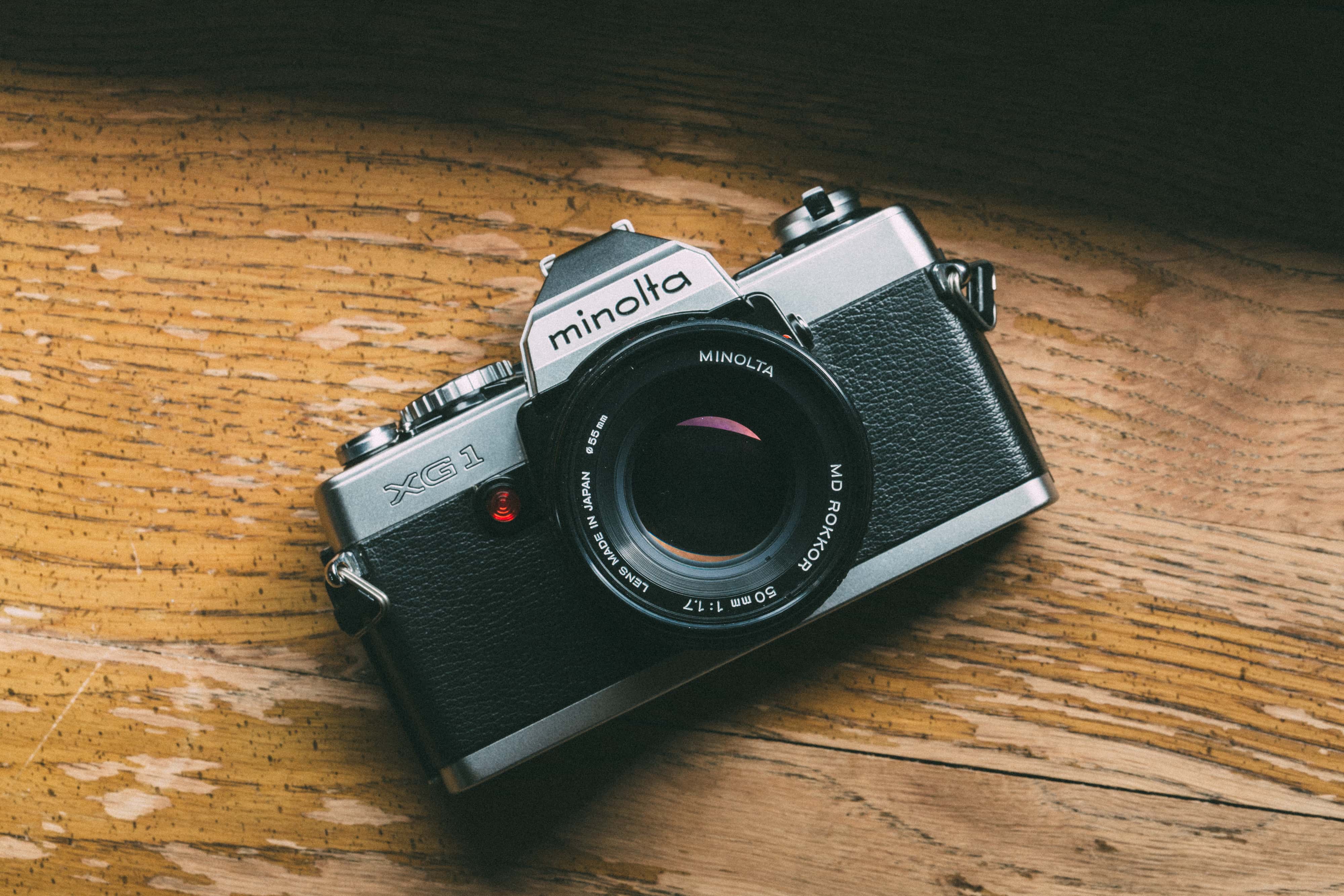
Format: 35mm.
Name: Is this camera officially called the Minolta “XG 1” or “XG-1” or “XG1”? You’ll see it written all three ways, and the confusion comes because the first version of the camera has no hyphen on its front plate and a later version of the camera added the hyphen (along with a new company logo). Minolta, however, included the hyphen in marketing material for both versions. Because the XG 1 and the XG-1 are essentially the same camera and function the same way, I’m going to sidestep the issue altogether and just call it the XG1 throughout this review. A later model called the XG-1(n), with a revamped body, replaced the XG1.
Dates: Manufactured from 1978 to 1981. So the same year that the XG1 rolled off assembly lines, Eddie Van Halen erupted on Van Halen’s debut album and changed guitar playing forever. The XG1 didn’t have quite the same effect on photography.
Cost and availability 2019: 35mm shooting is becoming en vogue again, so prices for used film gear have been steadily increasing. Happily, the cost of an XG1—neither an exotic nor rare camera—has remained fairly stable. You can find them all over eBay and in pawn shops. KEH, B&H, and Adorama sometimes have them in stock as well. Costs range from $15 for a body to $100 for a kit with a good 50mm f/1.7 lens. As always with film gear, buyer beware. If you buy from a respected camera retailer, you’ll likely pay more, but they will have thoroughly checked out the camera and accurately rated its condition.
Price update 2023: Surprisingly, prices for the XG1 have continued to remain pretty stable at 20 to 30ish bucks for a body in decent shape. It’s by no means the most satisfying 35mm camera on the market, but it’ll get you shooting without destroying your bank account.
Price update 2024: You can still find bodies in good shape for less than $50, but beware of eBay: some folks are trying to sell the XG1 for over $100 without even a lens. Definitely don’t pay that much.
Price update 2025: I’m seeing more and more bodies creep into the $70 range. That price feels less like a bargain to me for what the XG1 actually offers. An XG-M or X-370 is the more appealing Minolta option now.
Autofocus and lenses: No autofocus. The camera features Minolta’s MC/MD mount. There are a whole bunch of excellent and affordable MC and MD lenses available on the used market. If you are feeling fancy, look for MD Rokkor-X models. They are often more expensive than regular MD glass, but some photographers prefer the Rokkor build quality and coatings.
Battery: Yes, the camera actually needs two batteries to work at all, and thankfully they are readily available and cheap. The officially recommended battery model is the “Eveready A-76,” but you can use any of the following models from any brand: 157, 303, 357, AG13, EPX76, LR44, S76, SG13, SR44. I picked up a 20-pack from Amazon for 6 bucks.
Weight and construction: The camera weighs in at 1.08 pounds without batteries or lens. That’s almost the weight of Canon’s 17-40mm f/4L lens, so it’s not really heavy at all. At the time, the XG1 was very much considered a consumer camera, but it’s made of more metal than many pro and prosumer cameras today. It can take a fall I’m sure but not a bullet like Don McCullin’s battle-scarred Nikon.
Light meter: Yep, but it works only in aperture priority. In the viewfinder, you can see what shutter speed the camera has chosen. Shutter speeds are available only in whole stops in manual exposure. The meter is a center-weighted pattern.
Max shutter speed: 1/1000. Slow compared to modern digital cameras, but not unusually slow for the time period. Depending on your film’s ISO, you might not be able to shoot wide open with a fast lens on a sunny day.
Flash sync: 1/60. Also quite slow compared to entry-level digital cameras today. And again, you’ll have more difficulty shooting wide open outdoors.
Film advance and rewind: Both are completely manual and as old school as a film SLR can be. When photographers talk about an “authentic” 35mm experience, loading and rewinding film with the XG1 is what they mean.
Manual: The basics of shooting with an XG1 aren’t particularly complicated to figure out even if you have never used a 35mm film camera before…but it never hurts to have a manual on hand. Download a PDF copy of the XG1 manual from Butkus.
Background
The XG1 arrived on shelves in 1978, right in the middle of photography’s autoexposure revolution. At the time, the majority of camera customers—regular moms and dads and grandparents—didn’t want to fiddle with dials and knobs but did want to take great pictures easily and quickly and cheaply. The XG1’s aperture-priority system was designed to directly appeal to them.
And to appeal to them even more, Minolta signed on Bruce Jenner as a spokesperson. A beacon of U.S. pride because of his 1976 Olympic glory, Jenner told all non-photographer photographers exactly what they wanted to hear:
“Take pictures you never thought you could take. With a camera you never thought you could afford.”
The Jenner print campaigns below (courtesy of the amazing Rokkor files) are pretty staid compared to some retro camera ads, but the actual TV commercials?….Amazeballs cheesy. I totally love them.




But of course the camera wasn’t marketed with only the help of Jenner. A camera pitched to the average person also needed some ads that featured average folks and a soothing slogan: “Wait ’til you see how good you can be with a Minolta XG-1.” Lots of internal rhyme and a $25 rebate to boot? Who could’ve resisted?


Batteries and Turning the Camera On
Like with most SLRs from this era, the battery compartment must be opened with a coin or flathead screwdriver. Happily, the XG1’s two batteries will last a long while with average shooting (about a year according to Minolta), so you won’t need to change them often. I’ve had my XG1 since 2001 and replaced batteries only three times.
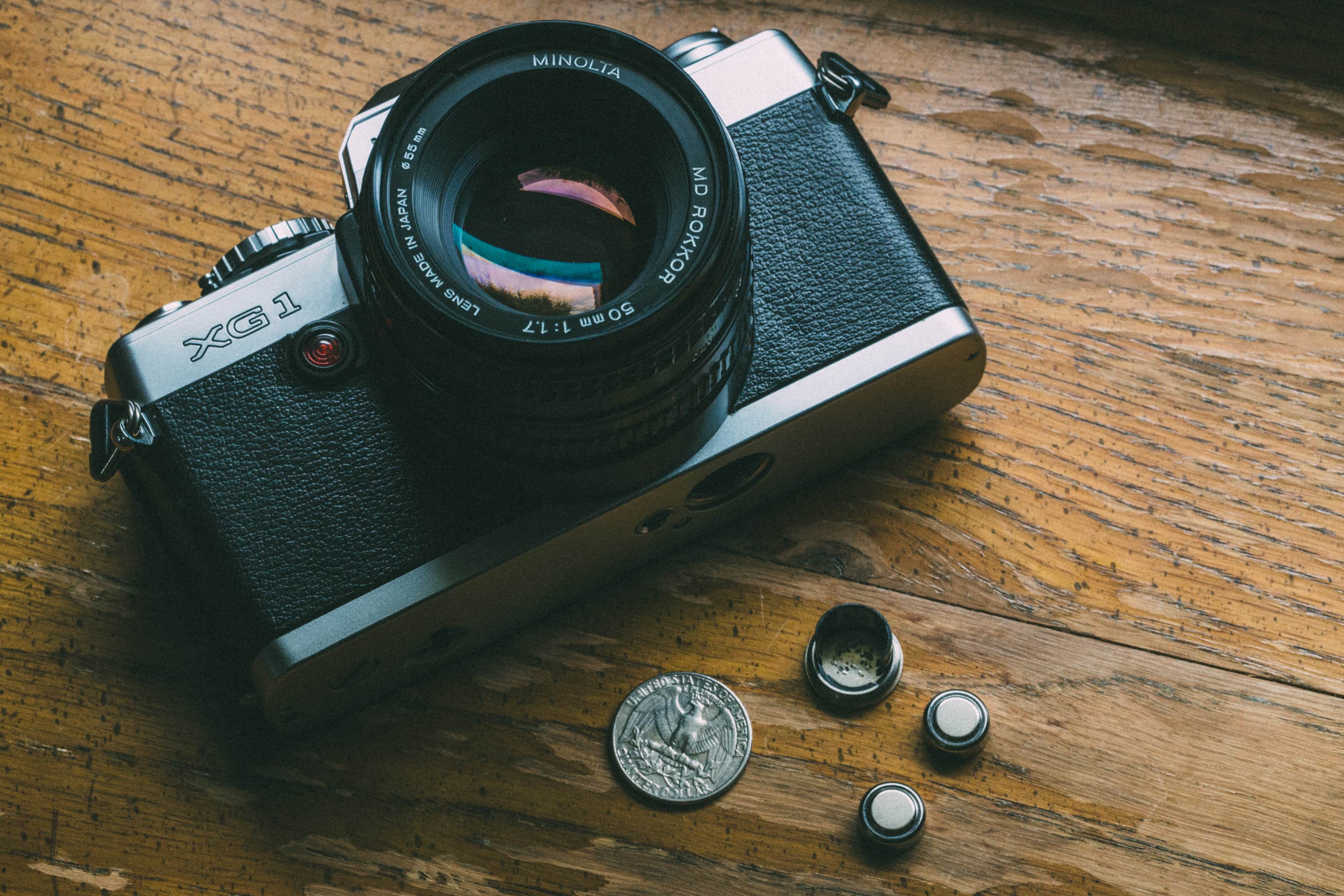

The power switch is located on the top of the camera and is labeled in gloriously plain English (no cryptic nonsense like on the Canon EOS 650).
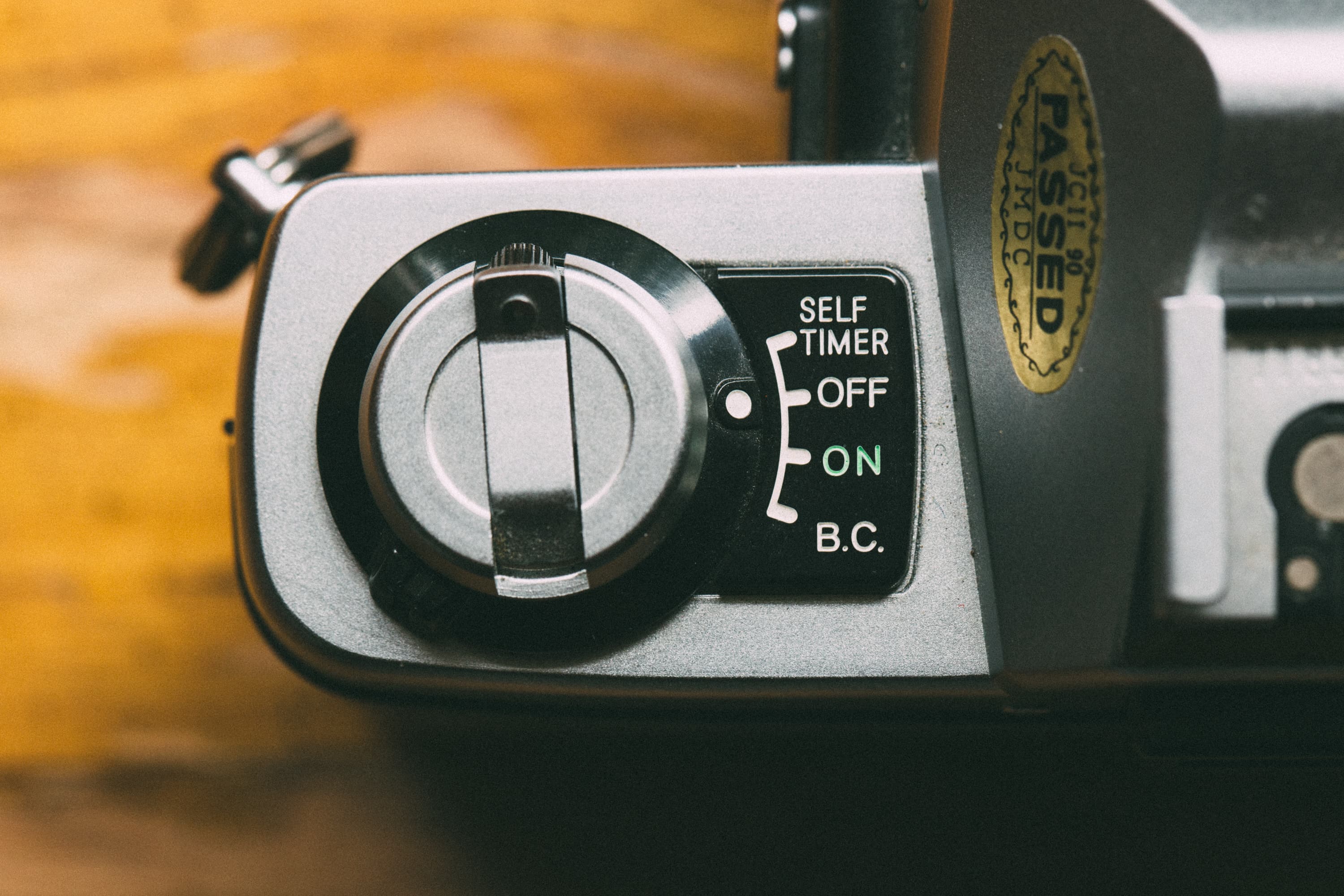
B.C. here stands for “battery check.” If the batteries are good, the large red light on the front of the camera will illuminate. The light also illuminates and blinks when the self-timer is activated.
Loading and Rewinding Film
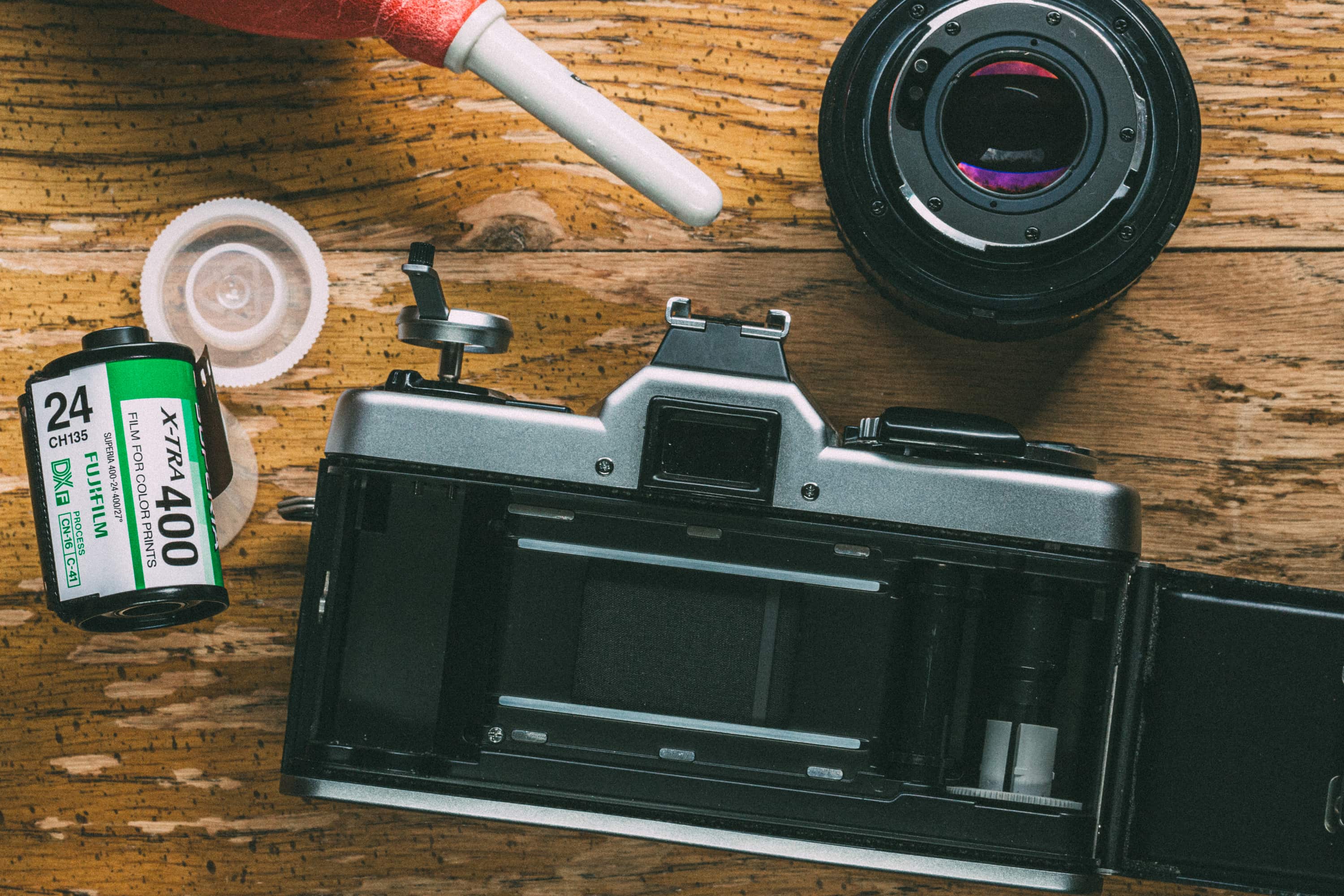
Loading film in the XG1 is not nearly as easy as loading film in the Canon EOS-1N or other fully automated cameras of the 1990s, where you can pretty much just throw a film canister in the camera’s general direction and it loads perfectly fine. I’ll take you through the process.
To get started, pop open the back cover by lifting the film release knob. Insert the film canister with the narrow end pointed down.
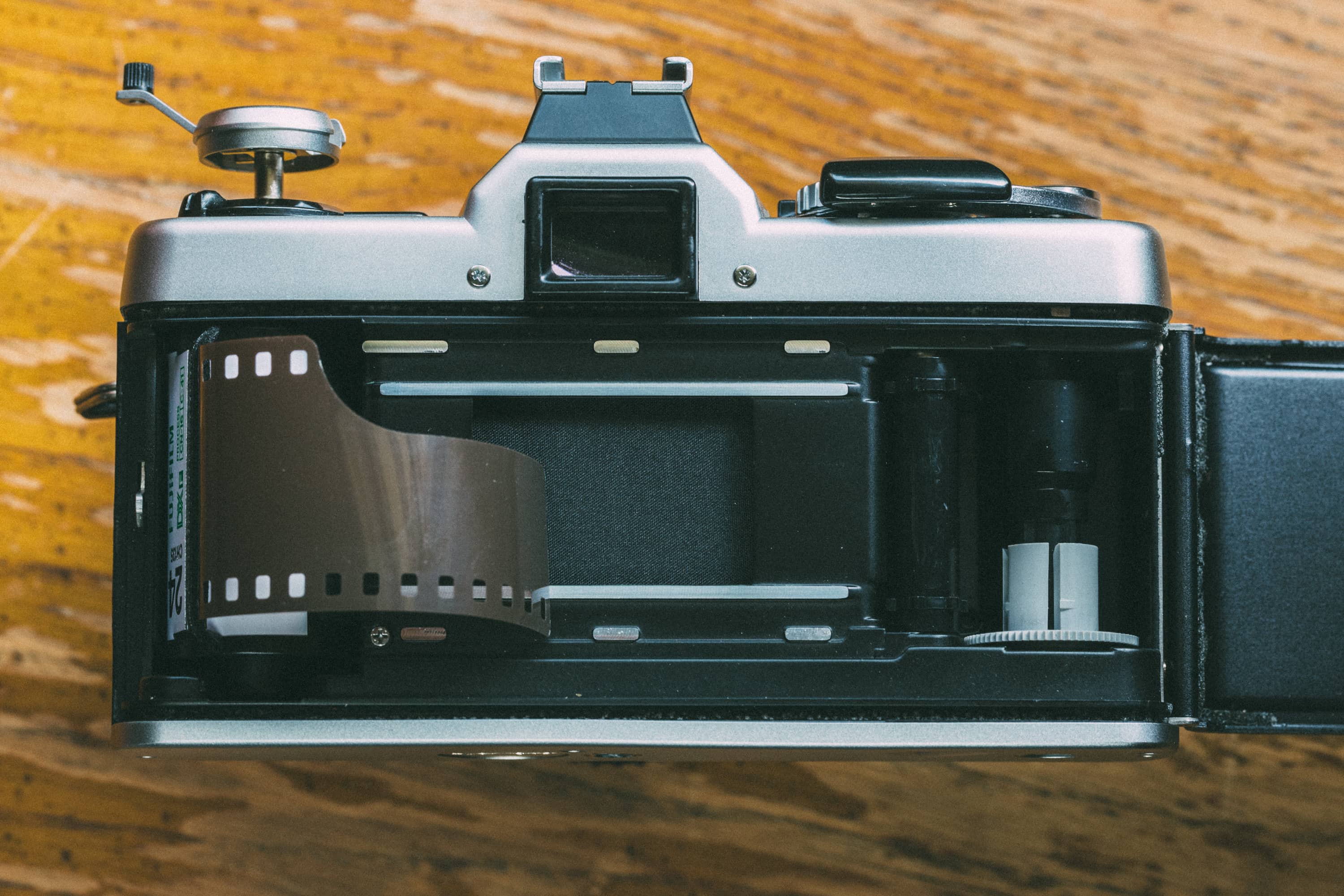
The film leader then has to be threaded into the spool. The gray area of the spool has little notches with sprocket teeth. Slip the film leader in one of the notches, and make sure one of the sprocket teeth is in the sprocket hole of the film.
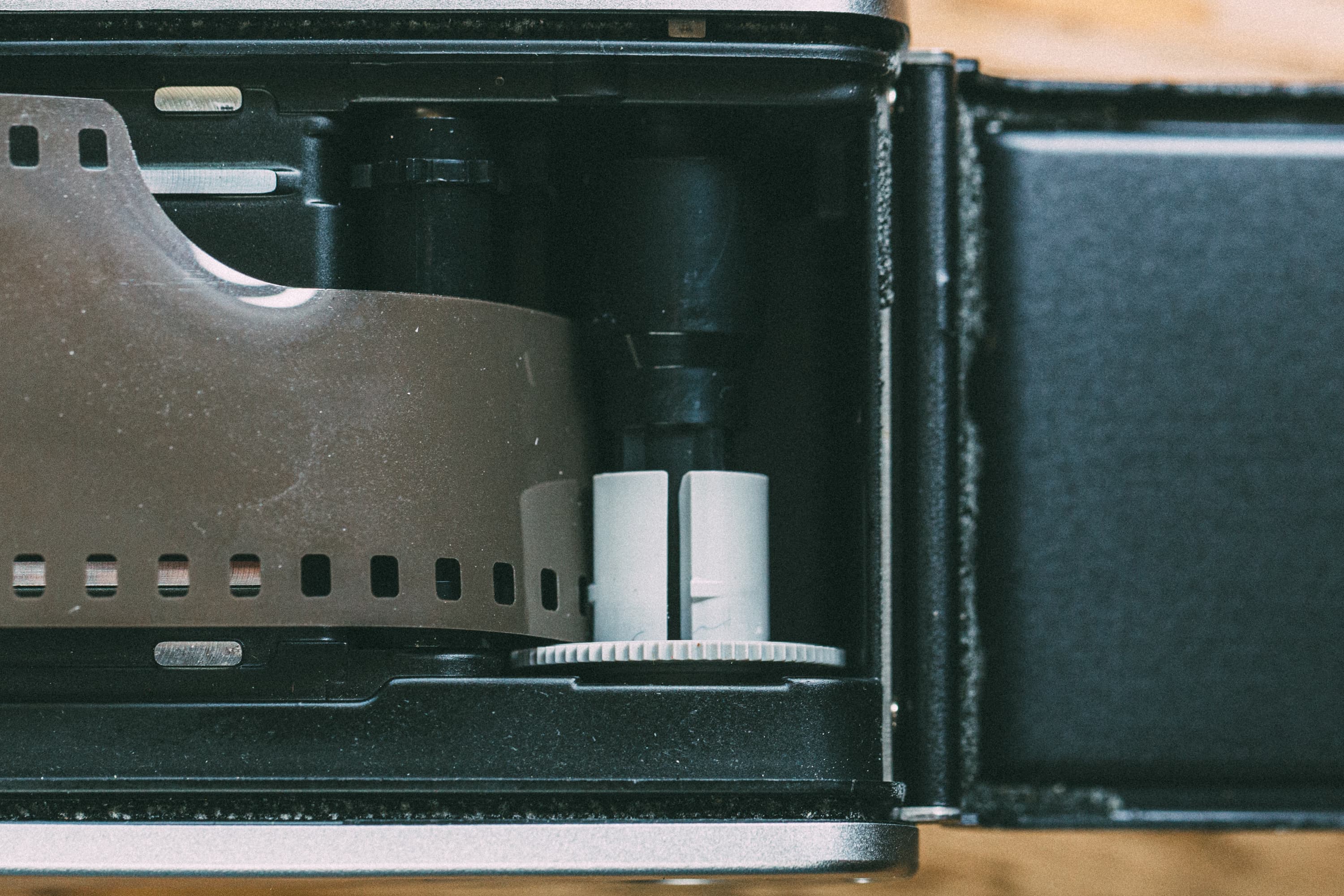
Once the leader is threaded, advance the film a couple of times with the advance lever so that it begins winding around the spool. Close the back cover, set the film’s ISO on the shutter dial, and you are ready to get shooting.
Two things happen on the camera’s top plate as you shoot the roll:
- The first is straightforward enough. The frame counter shows you how many shots have been exposed. The cool thing with a manual film camera like the XG1 is that you might be able to get more shots than the 24 or 36 the canister said it had. It all depends on how much film you initially wind during the loading process. I can usually get at least an extra shot from a 24-exposure roll.
- The red bar above the shot counter advances as you shoot. When it looks like in the photo below and the advance lever won’t cock all the way, you are finished with the roll.

It’s now time to start rewinding. First, push the little black button on the bottom of the camera. The button releases the film. Lift the arm on the rewind crank and turn it in the direction the helpful arrow indicates. As you rewind the film, the red bar above the frame counter rewinds too. When you can’t see red any longer, your film should be completely rewound.
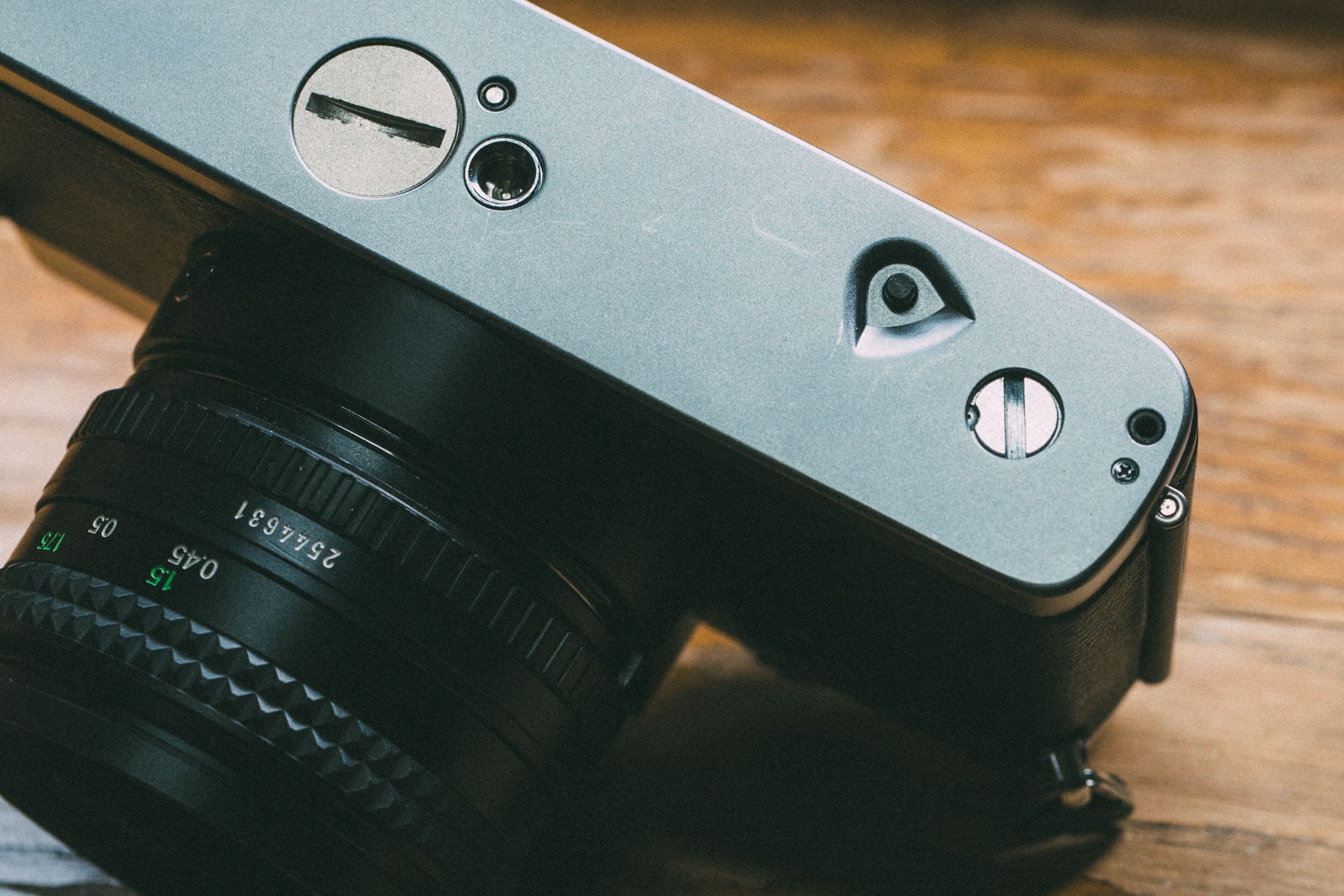
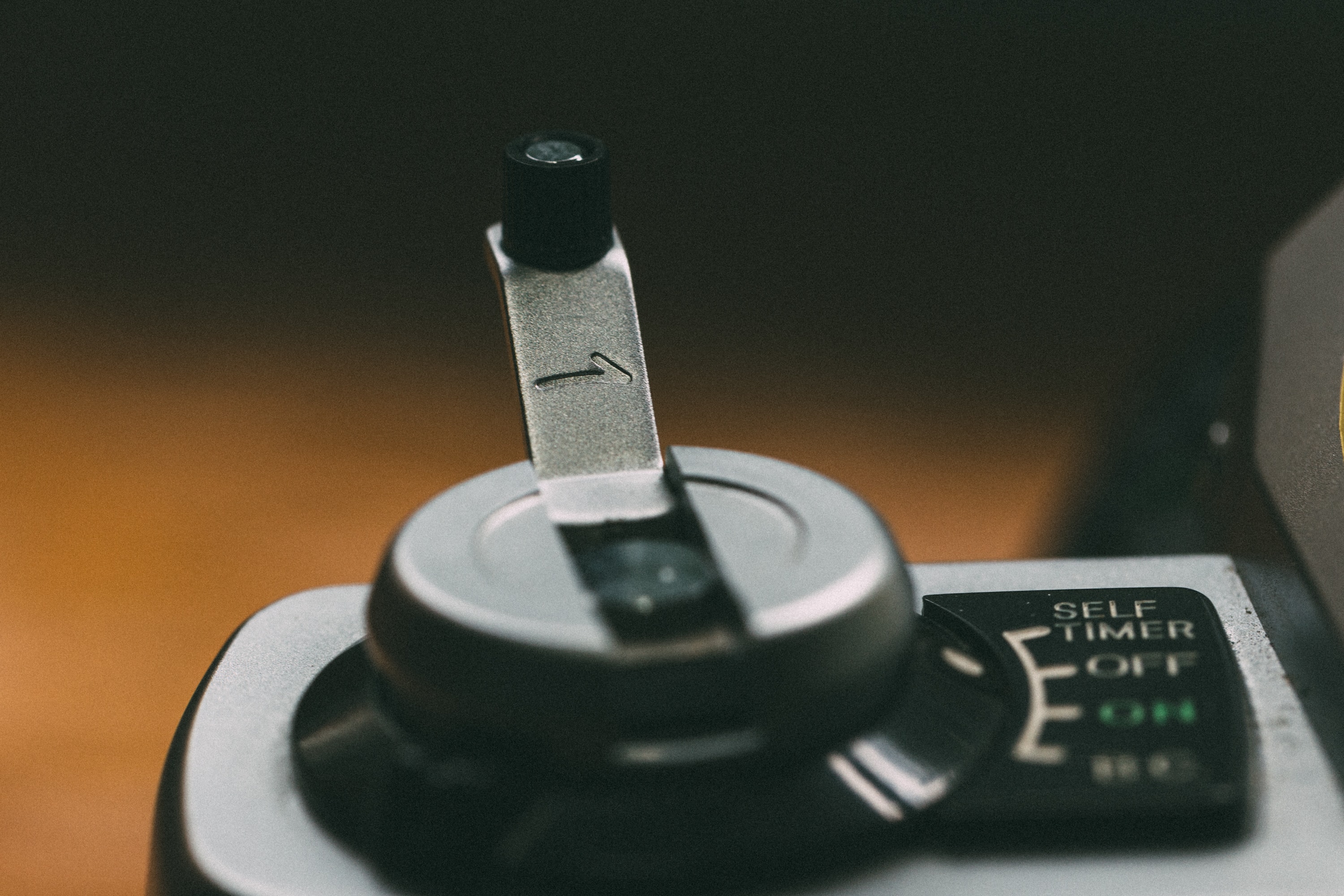
Exposure
Manual exposure is available, but you might as well forget about it unless you use an external light meter (though who really wants to do that with a walk-around camera?) or are comfortable with Sunny 16 guidelines. The camera’s light meter works only in aperture priority, which is really what the XG1 was designed to shoot. The center-weighted metering pattern produces good exposures, so as long as you dig AV, the camera will treat you fine.
One cool touch is what Minolta calls the “Touch Switch.” To start the meter with most cameras, you have to press the shutter button halfway. The XG1, however, senses your finger as soon as you lay it across the shutter button, and it begins metering right away.
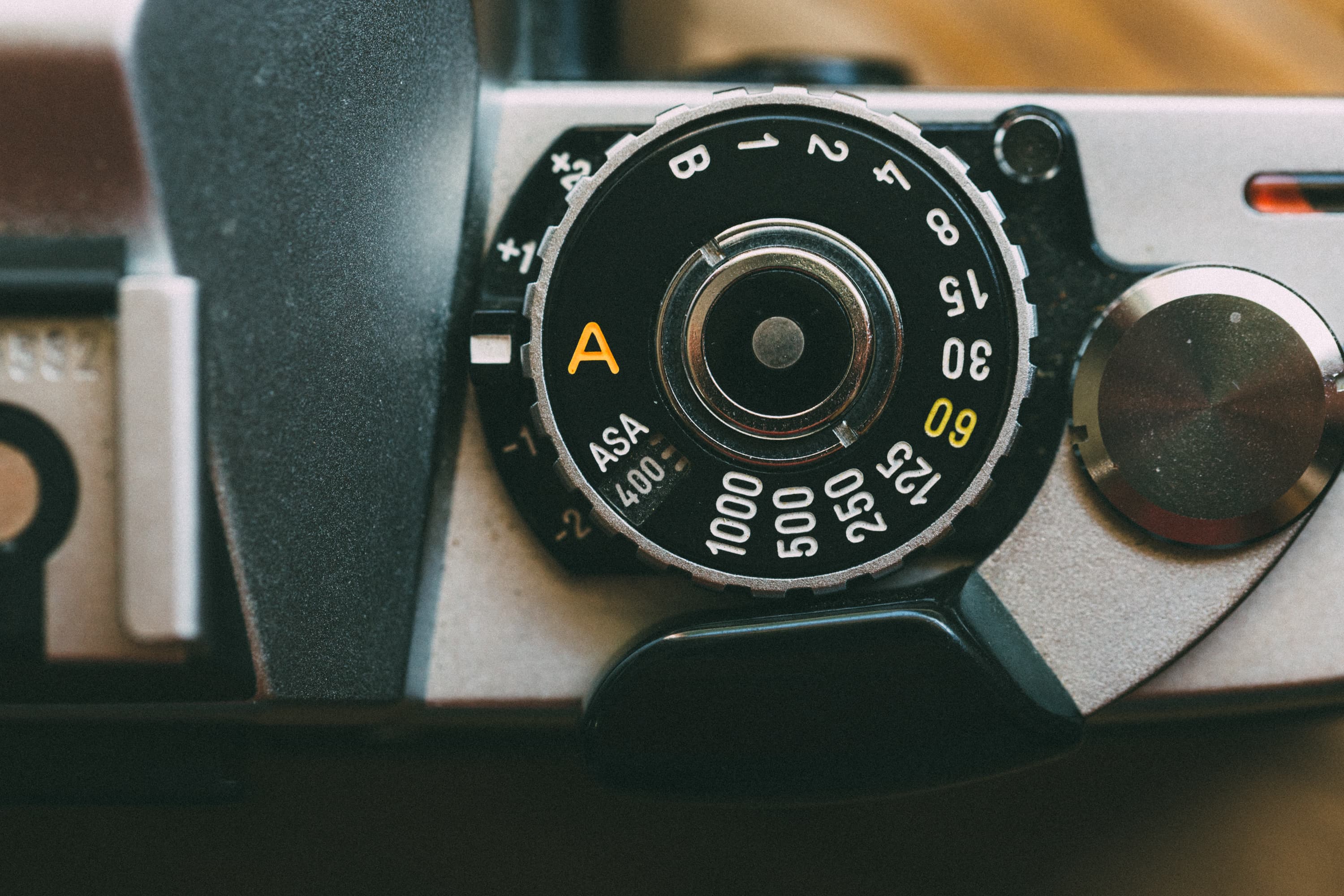
As you can see from the photo above, the ASA/ISO selector is integrated into the shutter dial. Fuji would later do the same thing on the digital X-Pro2, which is annoying, but on a film camera it’s a cool and practical way to save space and make the body more compact. Because you can’t change ISO between shots anyway (whatever film speed you load is the speed you get for the entire roll), there is no need to make the ISO selector more accessible.
Exposure compensation is also available—from two full stops of underexposure to two full stops of overexposure. To select exposure comp, rotate the shutter speed dial until the “A” is next to the one you want.
One strange thing: the XG1 will not allow the shutter to fire if the image is overexposed, but I can get it to fire if it is underexposed. Equally strange, the camera always selects its slowest shutter speed of 1 second no matter how underexposed the image is. I’m not sure if this is a legit “feature” of the camera or if something is broken on my copy. Whatever the case, the camera does not like shooting anything out of its range of shutter speeds.
Tidbits
The shutter sound. It’s audible but not obnoxiously so. It’s more spongy than metallic, more flat than sharp. It’s not entirely inspiring but not at all off-putting. Ultimately, I like it, especially for street shooting in a crowd or on the metro. Check out our vid below of the shutter sound.
The viewfinder. If you are coming from a crop-sensor digital camera, you’ll be amazed at how large the viewfinder is on the XG1 (and indeed on all film SLRs). The bummer though is that the viewfinder and focusing prism become very dark if your lens has a slow maximum aperture. I have an f/4 zoom that is painful to use indoors or in anything other than the brightest of sunlight. If you are going to invest in shooting with an XG1, stick with any of Minolta’s bright, light primes. Mine came with the bog-standard 50mm f/1.7, and it’s great.
Should You Buy One?
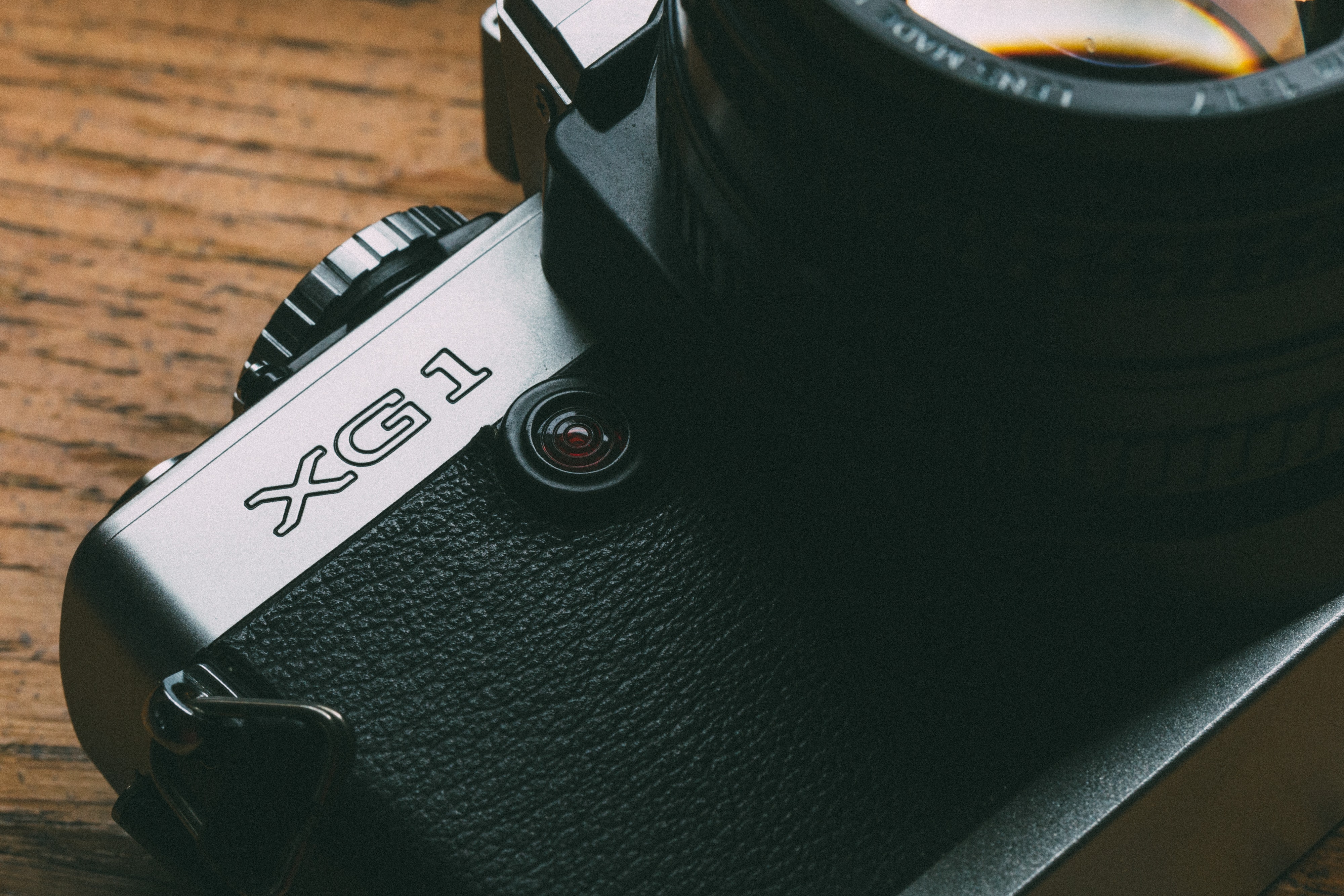
I want to say yes, but I know that want is the result of too much nostalgia. I got my XG1 in France back in 2001. It was a parting gift from a college girlfriend as I was leaving the country. Somehow she knew before I did that I would love film photography, and I’m grateful every day for that (life lesson: always date people smarter than you). Whenever I dig the camera out of a closet now, I’m dusting off not just a piece of photo gear but the rosy, wistful remembrances of Paris, poverty, and passion.
I’ll never get rid of my XG1.
…But I wouldn’t have gone out of my way to actually buy one. And neither should you. The Minolta XG1 is a perfectly decent, inexpensive camera, and it’s a great gateway to Minolta’s addictive Rokkor lenses. There are, however, more solid options available for budding and experienced 35mm photographers. Manual-exposure purists are better served by a Pentax K1000; automatic shooters should look at one of Canon’s very popular A-series cameras; proper film fanatics already have eyes on a Leica or Contax.
So unless you just really, really need a quick gift for a departing partner and eBay has run out of every other film camera, save your cash.




Comments
I liked the review. I bought one Jan 2006 I liked the lens that was with it, not sure what lens now.
I collect minolta cameras & lenses. Well I took it out today & I have been reading it up. As against the SR 1 etc it is very light. I was pleasantly surprised, it is in a nice condition. It must have been inexpensive as I was not spending much more than £ 10. Since then Minolta vintage equipment has at the least trebled in price. I found some batteries & off it went, so I will have to so try film some day soon. Take photographs of my Cacti as quite a lot are in flower. Stay safe all the best.
Nice camera, I own one. Bought xg1 in 2019 for 30 usd with a great 50mm f1.4 rokkor lens
I have my dad’s old SRT-101, I love to shoot it but batteries are a pain. Along with it came two 58mm, the 1.4 and the venerated 1.2, plus a J.C. Penny 28. I’ve picked up a few others over time as well. Add to it my Maxxum 7000 and lenses, and I find myself well-invested in Minolta. I’ve been tossing around an XG-1 or similar so as to avoid the battery situation. It’s not a perfect camera, but still fun. I sometimes find myself shooting quickly, making grab shots. A program mode like Aperture Priority makes that a lot faster.
Thanks for that review. I have an XE-5 which is very nice but the meter is not operating dependably, so I’m looking at other more recent models from Minolta for my Rokkors.
There’s the X 7-300 series and there’s this one.
Both from the early 80s so should have better chance of having a working meter.
And i’m looking at one with Minolta’s 35-70 zoom for around $40.- in mint condition.
Should be a no-brainer.
The XG-1 will be the one to get.
I bought my XG1 in Singapore around 1979. If I remember correctly it had a 45mm lens on it. I have since had my nostalgia re-invigorated by reading this article and looking at the plethora of MD/MC lenses available. I was wondering how good they would be on my XH1 and XT2 obviously in manual focus. Has anyone any experience using them on Fuji Cameras.
I’ve had my XG1 since the early 80’s. Recently I put fresh batteries in and it won’t work sadly. I even got another set of batteries to check. I can’t get the shutter to advance or the BC light to come on. Was really looking forward to loading some film.
I had the same problem in mine. Apparently the metal tab in the battery slot in the camera was not making good contact with the batteries? I (GENTLY) bent the tab up a bit, towards the batteries and then it worked OK.
I was recently given an XG-1 for free, and while it lacks some of the common features advanced shooters may take for granted, don’t sell it short – it’s still a solid, well-performing camera that takes perfectly acceptable shots all things considered. Having only recently made the jump full-time to a DSLR after using a Canon 35mm for nearly 30 years, it was an interesting experience recalling the need to make every shot on a roll of film count. And that need, to simply slow down on the shutter finger, is something important that is being lost from the art of photography in our modern age of endless digital storage space.